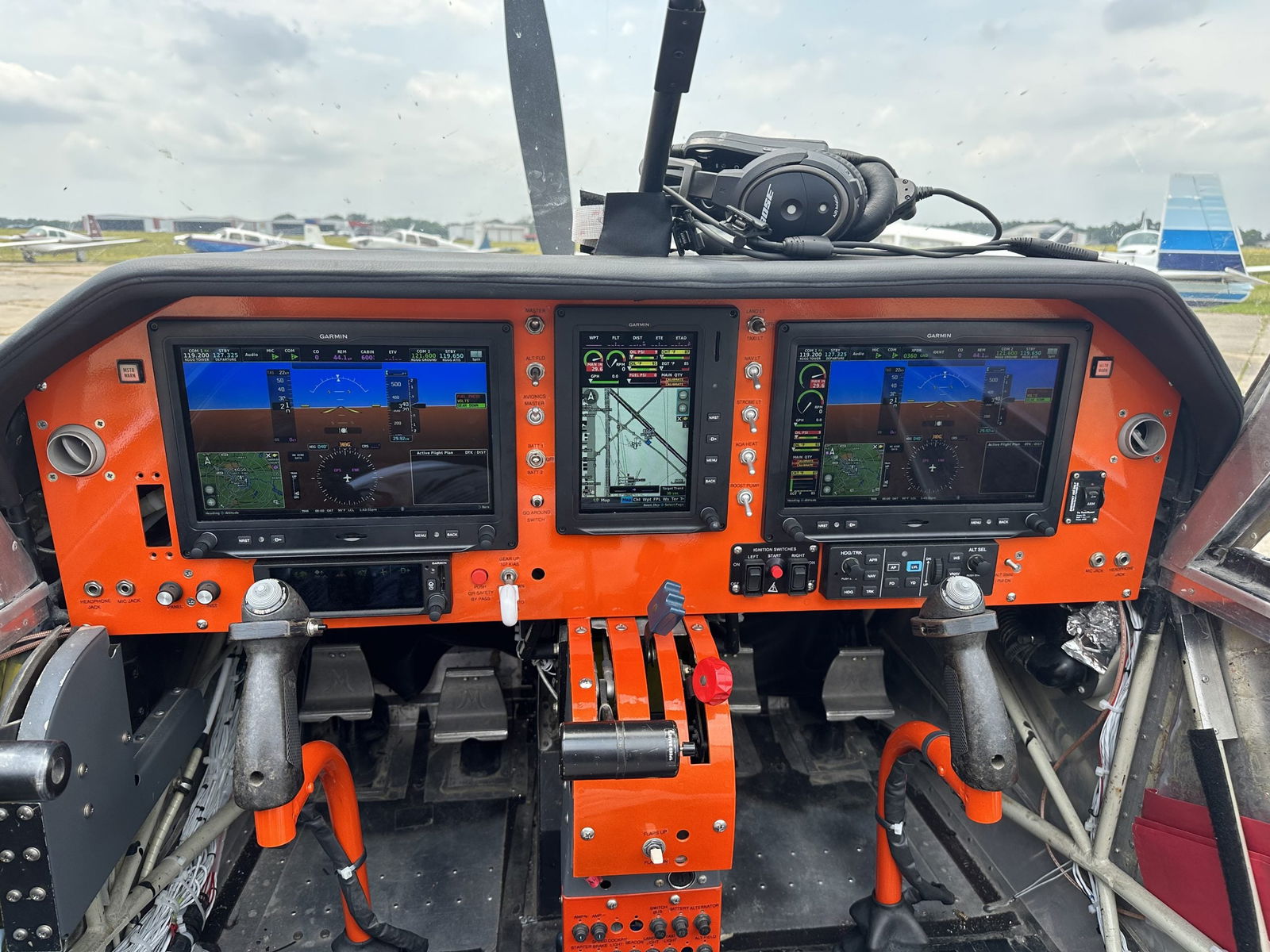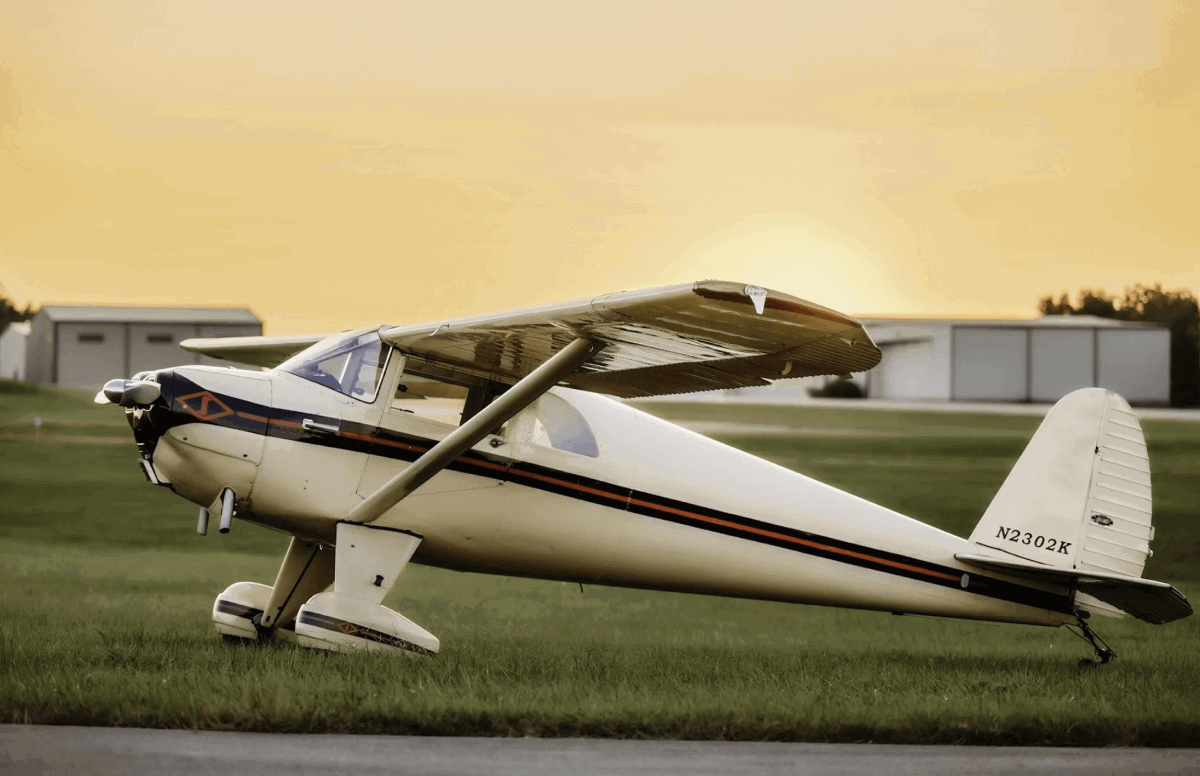Piper built thousands of L-4 “Grasshoppers” used as liaison and artillery spotters. Cessna’s T-41 trainer was a Skyhawk in military colors. Beechcraft has pressed a variety of designs, from Staggerwings to King Airs, into service.
After a two-year restoration effort, the one surviving airframe from Mooney is all that remains of the company’s dual attempts to gain military contracts. It now prowls above Texas after decades on the ground.
Mooney’s absence from the warbird scene is not for lack of trying.
Company founder Al Mooney designed the Culver Cadet, which was used as a World War II military trainer and drone, and after the war he pitched a lightly armored version of his Mite, a wooden, single-seat design as a light attack aircraft that could also target enemy light observation aircraft. The U.S. Army’s evaluation in 1951 produced marginal reviews, and the design was relegated to the dustbin. It handled well but would have been an easy target for any meaningful enemy air force presence.
Later, another military opportunity for Mooney came along with the Enhanced Flight Screening program. Competing designs in this program sought to replace the Cessna’s T-41 as a training aircraft to screen pilot candidates economically in a 20-hour course before they progressed to more expensive aircraft. The competition came to a head in 1992. Competitors included the SIAI-Marchetti SF.260, Piper/LoPresti Swift, Aerospatiale Trinidad, Slingsby Firefly, and Glasair II and III.
Mooney built the M20T as a contender for the EFS competition. Much of the airframe used off-the-shelf airframe components that marked it as a Mooney product. The fuselage was modified from an M20C, the wings from a later model, and the large tail from the company’s M22 Mustang, a short-lived design that might have rivaled Cessna’s P210 but beat the pressurized Centurion to market by more than a decade—and that market segment hadn’t developed yet.

Equipped with a sliding canopy over two seats and control sticks, the M20T was unmistakably geared for military service. Under the wings, four hardpoints gave the Predator teeth in the form of missiles, light rockets, or gun pods.
Much like the 1951 effort, the Predator showed well—but not well enough. The official reason for its rejection was that the M20T did not recover well from spins with a full load of fuel. Mooney wings are lauded for their strength and stability. The former was an asset, the latter a liability in this design. Roll rates were lackluster, failing to meet design criteria despite numerous revisions to the ailerons. Spin recovery has never been great with the Mooney design, and that was really the nail in the coffin. A one-turn spin was easily recoverable with quick recovery inputs. A two-turn spin took another four turns to recover; a four-turn spin wasn’t recoverable. Mooney withdrew from the competition before it ended.
The winner was the Slingsby T-3 Firefly, which raised some eyebrows: “Made in America” was a stipulation of the contract, but Slingsby built most of the airplane in the U.K. and assembled it in the U.S. After a brief few years in service, the U.S. Air Force grounded the T-3 fleet in 1997 after a pair of spin-related accidents and an engine failure. They were destroyed in 2006.
Meanwhile, the M20T prototype had gathered dust at the Kerrville, Texas, factory. Jacques Esculier, the company’s president, ordered the prototype destroyed. The engine went back to Continental (it had been loaned for the venture), but the employees in Mooney’s R&D complex were more than a little attached to the machine they’d poured so much work into. In a clandestine effort, they disassembled the airframe and pigeonholed it in various spaces across the facility. And there it stayed hidden until it found a champion.
Former Mooney chief operating officer Tom Bowen recalled his first encounter with the design. “In 1995, the research and development team staff gained enough confidence in me, and they said, ‘We have something to show you—this project we’d really like to work on.’” The workers took him through the
hangars where the pieces of the M20T were scattered. “I knew a little about the program, but it hadn’t been my focus.”
Bowen received permission from the company’s president for the workers to resurrect the project, but Mooney was being prepped for sale so they had to do so without any meaningful budget. “So we begged, borrowed, and might have stolen a few pieces from the production line,” Bowen said of beginning to reassemble the airplane. Working evenings and weekends, the airplane began to come back together, this time with a Lycoming AEIO-540 under the cowl. The bird had never been underpowered, but this engine promised even more performance.
Now registered as N20XT, the unique Mooney took flight again, and Dirk Vander Zee, then Mooney’s vice president of sales and marketing, dubbed it the “Predator.” The name stuck, and the Predator gained its memorable paint scheme after Bowen’s daughters, armed with a three-view drawing and a box of crayons, colored in tiger stripes. In the hands of longtime Mooney experimental test pilot Mike “Mikey” Miles, the Predator took flight, and Miles started checking out the other Mooney test pilots in the bird.

The whole rehabilitation project had stayed beneath leadership’s radar, and on June 30, 1997, Bowen taxied the mostly complete Predator, its test time already flown off, to the main headquarters and parked it in front of the office of Mooney president Bing Lantis. “The offices all have windows out to the ramp, and as I walked in, he was speechless,” Bowen said. Lantis went for a ride, and magically, the team had a modest operating budget for the program. With a few bucks to use, the crayon on paper became paint on metal, and soon the bird was ready to display.
The Predator parked at the Mooney Aircraft Pilots Association tent that year at EAA AirVenture, and the next it was front and center for Oshkosh and the Sun ’n
Fun Fly-In.
The R&D team continued to tweak the design, modifying the flight control sizes, then adding and adjusting servo tabs to eke out every bit of maneuverability it could. The work was well outside the norm for Mooney’s engineers, who had built generations of stable, efficient aircraft but sometimes overshot their goals and had to rein back the project when it became too unstable. What they wound up with, Bowen recalled, was not the fingertip-flying mindbender that some would imagine.
“It’s not a two-finger machine,” Bowen said. “But it is a pleasant airplane to fly with one hand on the stick.” The 90-degree-per-second roll rate hoped for initially never really came to be—50 degrees per second is where it settled in, and inverted flight was never all that great, taking an aggressive nose-up pitch of 10-12 degrees to hold level inverted. “But it looped great, pulling only about 1.8 to 2 Gs.” It was speedy—160 knots or so in cruise, but the straight exhaust pipes with no mufflers made for a very noisy experience until ANR headsets came along.
Dreamers drooled over the design, but nobody was ready to pony up the bucks for orders, and when Bowen left Mooney, the Predator hardly flew. After a period of dormancy, the Florida Air Museum asked to display it, and it was ferried to Lakeland, where it sat for several years. It eventually wound up back in Kerrville at the Mooney factory, once again forlorn.
Don and Paul Maxwell, the father-son team at Maxwell Aviation, made an offer to the newest owners of Mooney: They’d restore the Predator to flight status if they could get permission. One might argue that short of the factory itself, Maxwell Aviation—one of the nation’s most popular Mooney Service Centers—would be the perfect place for such a project.
In 2020, the Maxwells showed up at Mooney’s Texas factory to bring the Predator back to their shop, but it didn’t fly home. The solid wing, a design trait Mooney owners brag about when it comes to comparison with other GA aircraft, becomes a liability if you want to haul a Mooney home. The crew from Maxwell Aviation set to drilling out the bulkhead’s rivets just aft of the cabin’s steel-tube cage and separated the tail, setting the pieces onto a flatbed trailer for transport.
The restoration took two years of part-time work as Paul led the effort, overhauling the engine and rebuilding the airframe. The M20T wing had featured larger-than-stock ailerons. Paul and his crew replaced that wing with a M20K wing, which brought them back to stock ailerons and flaps. The elevators had featured servo tabs to lighten stick forces, but after a few flights the team replaced them with stock equipment.
“Unless you’re going to be flying aerobatics every single flight, the older elevators were overkill,” Paul Maxwell said.
The Predator’s entire existence had ridden out numerous ownership changes at Mooney and a shoestring budget all along, but now the Maxwells have heaped the goodies onto it. Its instrument panel now features Garmin G3X Touch displays with engine instrumentation, CIES electronic fuel senders, and a Garmin GFC 500 autopilot.
The fuselage’s tiger stripes were replicated and extended to the wings. Carbon monoxide in the cabin was an issue all along, but the Maxwells have sorted that out, and it now has a Guardian CO detector. Sporting a 300 hp Lycoming AEIO-540 on the nose, the Predator certainly has the power to push you back into the seat and plaster a smile on your face.
“It’s a 170-knot airplane,” said Paul Maxwell. “It’s not as fast as a Bravo, but it will outclimb all the other Mooneys.”
The Predator returned to flight March 18 and recently attended a Mooney Caravan formation clinic in San Angelo, Texas. The Caravan clinic provides training through the year at regional venues before a giant formation arrival—with tentative plans for the Predator to lead it—at AirVenture in Oshkosh. The Predator will also be on display at MooneyMax, a Mooney-specific symposium in Longview, Texas, on June 22 through 25.
As for its future, what the Predator can do is limited mainly by regulation—it’s registered as experimental-exhibition. “Despite being factory built, it has more restrictions on its use than something built in a garage,” Paul said.
But he intends to fly it to Oshkosh for every AirVenture as long as he lives, and it will actively participate in Mooney caravan clinics as well as attending other, smaller events.
Editor’s note: This story appeared in the July 2023 issue of Plane & Pilot magazine.




